In the world of Web analysis the software title Piwik should be very attractive to those in the open-source sector. Piwik is an open-source Web analytics program (General Public License) that works in real time.
Key features include detailed reports about visitors to your Web sites as well as specific information on the keywords and search engines used to reach your location. You can also track data related to most popular pages.
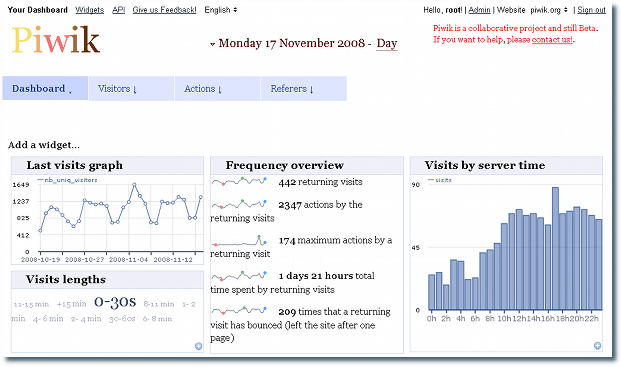
One of the nicest features about Piwik is that you can use it whether you speak English or not. In fact, the software is available in more than 30 languages already and the number is growing.
Interested individuals can try Piwik with an online demo. To install Piwik you only need to download the latest release, upload to your Web server and open your browser. *PHP 5.1 and a MySQL database are required. Installation will take about five minutes and should be automatic. It can be downloaded from the Web site as “an open-source alternative to Google Analytics,” according to www.piwik.org. The download provides a JavaScript tag that can be copied and pasted on Web sites you would like to track.
What’s in Piwik
It’s easier to describe what is not included in Piwik 1.0 than it is to list all the tools and features available. Think of this as a very complete analytics program that “won’t provide advanced web analytics features that can be found in other commercial products: custom report generator, custom segments and real time segmentation, funnel analysis, advanced ecommerce reporting, etc. Some of these features could be built in plug-ins, but require significant effort and challenge to make them work with high traffic websites. We are building an open web analytics framework that people will use to later add these advanced features.” (Piwik Web site)
The Piwik team emphasizes that if a developer builds a feature that is not included already team members will “definitely work with him/her to integrate the feature in Piwik!”
Marketing information from the Piwik folks states that the real-time analytics reports help separate this software from the competition. Report frequency can be selected for high-traffic Web sites. New features can be added and unneeded features can be removed, primarily because Piwik features are “built inside plug-ins.” Developers can build their own analytics plug-ins with ease. According to plan, Piwik is installed on the users own server. “You can get all the statistics using open APIs (publishing the data in may formats: xml, json, php, csv).
The user interface can be customized, with reports fine-tuned to individual use. You can view your activity with a last-visits graph that shows the highs, lows and baseline numbers you need to understand how your sites are working. View a list o external Web sites with associated information such as visits, unique visitors and action per visit. Follow your visitors with a chart that shows browser use by family and with a map showing country of origin. Of course, the keyword list by number is essential information displayed in the easy-to-read user interface.
Inside Information
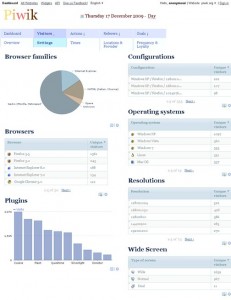 We mentioned earlier that PHP 5.1 and a MySQL database are required for download and use. PHP (Hypertext Preprocessor) is a general-purpose scripting language designed for Web development, with the goal of producing dynamic Web pages. (Wikipedia) PHP performs operating-system tasks and may also work as a graphical application.
We mentioned earlier that PHP 5.1 and a MySQL database are required for download and use. PHP (Hypertext Preprocessor) is a general-purpose scripting language designed for Web development, with the goal of producing dynamic Web pages. (Wikipedia) PHP performs operating-system tasks and may also work as a graphical application.
The MYSQL database is recognized as the world’s most popular open source database because of its consistent fast performance, high reliability and ease of use.” (www.mysql.com) MySQL is the database of choice for numerous applications and runs on “more than 20 platforms.”
This type of foundation allows Piwik to be implemented with relative ease when you want to track Web activity with accuracy. As the Piwik team has stated, the project started with a goal of producing a “solid Web analytics product.” But the individuals took the process a step further and focused on “a great user experience.” It seems they have hit the mark, as users report a painless installation process, a good interface design and reports that first-time users will be able to understand right away.
In the effort to encourage “an active community” Piwik has focused on documentation for users and developers, strong forums and plug-in construction so that developers can “customize Piwik, record new custom data or access new reports.” The Web site sends out a call for people who are interested in translations or beta testing. Developers are directed to the “developer zone” to find out how to build Piwik plug-ins.
Developer documentation includes:
Perhaps the most important factor separating Piwik from Google Analytics is the open-source foundation. Google Analytics started out with proprietary technology that often tailored reports and data to those who use other Google services. Piwik was introduced in France and has gradually built a large following (30 languages)!! Even if other Web analysis software is free, Piwik stands a better-than-average chance of gaining an even larger foothold in the Web-business world.
Piwik is open source analytics for the user and the developer. I would image that the entire search engine optimization community would be very interested in a strong alternative to Google Analytics that is free.
One of the key factors in business success is leverage. Microsoft Advertising Intelligence allows you to leverage true history and forecast data. This means your keyword efforts are based on actual customer activity. You get key performance indicators (KPI) to track performance.
The full name of this tool is Microsoft Advertising Intelligence. It is designed as a research and optimization tool that works with Microsoft Office Excel 2007, providing keyword expansion, pricing, KPI data and research. What this means for the business person is that you can make the most of your marketing investment. You’ll need to uninstall the earlier versions of adCenter Add-in for Excel. Of course, you should have Microsoft Office Excel 2007 installed. Be sure Excel is closed when you go through the Ad Intelligence install process.
With Ad Intelligence you can work with lists of suggested keywords, and develop your strategy for keywords using MSN and Bing query information. The details include volume, relevance, demographic and geographic tracking as well as cost history. This data helps you fine tune your bid strategy because you use actual pricing information and data that is specific to keywords. You get information on clicks, impressions, cost-per-click and position.
As product information for Ad Intelligence states, “Search activity reflects real time consumer behavior which helps determine the best planning approach for your online and offline campaigns. This ensures you are talking to your consumers with the right message, at the right time in the right place, to build truly integrated campaigns.”
Planning for Success
It’s tempting to get into the online marketing business because it seems the “hot” thing to do. But if you want to increase the chances of success you should devote some time to planning first. Microsoft Advertising Intelligence is designed to assist you in that planning process. For example, your working campaigns will be constructed on reliable information, data that allows you to make good decisions.
Ad Intelligence means using keyword search tools built into the Excel program as well as developing keyword lists based on actual behavior and trends. Data you can use includes relevant rankings that will help you understand how this will add value to the effort. You will be able to use your business budget on campaigns that actually work!
Features that will help your efforts succeed include a keyword wizard that lets you pull keywords out of an Excel list or from a specific URL. You can then expand your keyword list based on bidding association, similarity of categories or keyword phrases that contain the single keyword. You can move a detailed report containing estimated search volume, ad position, click-through, click cost for a specific range of dates etc.
Search buzz focuses on top-category keywords, with almost two dozen core categories available. There are dozens upon dozens of subcategories. If you are familiar with the usefulness of “spiky” numbers you’ll find that Ad Intelligence uses the above-mentioned categories but focuses on spiky keywords. Features include spike start and end dates as well as spiky index. One of the key features allows you to set your information to all verticals so you can uncover the leading spiky keywords or top search queries.
There’s More!
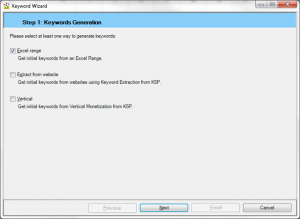 Microsoft Advertising Intelligence offers keyword-focused tools such as extraction that is based on input URL. You will be able to set the maximum number of keywords up to 100. It even allows you to establish a minimum relevancy so you can tailor your confidence level. If you are not sure of the efficiency of a certain keyword the tool has keyword suggestion to help you. Suggestions are based on such details as long-tail keywords containing the core keyword and on advertiser behavior.
Microsoft Advertising Intelligence offers keyword-focused tools such as extraction that is based on input URL. You will be able to set the maximum number of keywords up to 100. It even allows you to establish a minimum relevancy so you can tailor your confidence level. If you are not sure of the efficiency of a certain keyword the tool has keyword suggestion to help you. Suggestions are based on such details as long-tail keywords containing the core keyword and on advertiser behavior.
Other features include:
One of the nice tools available in Ad Intelligence is keyword normalization. This means that the software will find and flag duplicates in an advertising group. The feature might select a keyword if it has extraneous characters or if capitalization is a bit different. This process takes place automatically and will save the use a lot of time. You don’t have to manually manage variations of the same keyword.
Extraneous characters might be quotation marks, hyphens, asterisks, parentheses, brackets and many other common symbols. Extraneous words such as “a” and “an” may trigger normalization as well.
The advertiser can remove duplicates or remove the original. With the automatic task in Ad Intelligence and some careful editing by the advertiser this feature will mean more search queries match chosen keywords. Advertising return should be increased with this fine-tuning process.
This group of tools is designed to help advertisers improve their online advertising results through accurate modeling. Business owners will be able to more correctly predict intent of the user because of the specific data based on keyword and phrase selection. This can be an awesome tool in the online commercial world. Why? Because the way people search is determined by geography, demographics, age, gender and other factors.
Keyword and search characteristics provide a nice overview of the target audience. An advertiser use Ad Intelligence is able to learn more about a user’s intent and discover a doorway into a social network that this user is part of.
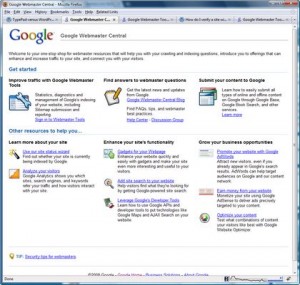 It’s all about the details. The application provides more detailed information for each search query. A site’s pages were reported using average position. Updates introduced in the past year allow users to find the number of “impressions” and the “amount of clickthrough.” Impressions are the instances that the site appeared in search results. Clickthrough measures the “number of times searchers clicked on that query’s search results.”
It’s all about the details. The application provides more detailed information for each search query. A site’s pages were reported using average position. Updates introduced in the past year allow users to find the number of “impressions” and the “amount of clickthrough.” Impressions are the instances that the site appeared in search results. Clickthrough measures the “number of times searchers clicked on that query’s search results.”
Webmaster Tools was designed to provide “information and data about the sites you have added to your account. You can use this data to improve how search engines crawl and index your site’s content.” That’s the basic task for this tools application, as described by Google. But there is more to this than what we have become used to.
The Webmaster Tools now generates charts and displays them in the report page. Query information can be isolated for a specific period of time as well. Now, when a site ranks for more than 100 queries there will be new buttons that allow Web managers to find out more details. The improvements should save time and money if used correctly.
For those who have been using Google Webmaster Tools the addition of new backlink statistics will be a nice change. Everyone who wants to succeed in the online world should know about links and linking, whether they use them fully or not.
But not all links contribute to Web success. Proper linking does. If you can get a handle on the idea of backlinks you are even more likely to have a positive experience with your sites. You see, backlinks are essential in the search-engine visibility and ranking world. The key word in the new online community is conversation.
If you get reliable, usable links from pages that are relevant to what you are doing is very important. Webmaster Tools now has a piece that helps you keep track of who is linking to whom, with details such as pinpointing the page on the referring site. This information is now offered in a format that is easier to use. Check into Webmaster Central Tools (sitemap) if you are a registered Web site owner.
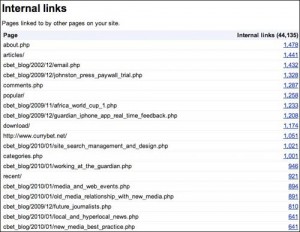 Internal Links – Count per page tells you which pages are linked to from pages on your Web site and also shows the number of links on your Web site that point to each of the linking pages. Some of the newest linked pages may not appear right away, perhaps because your link isn’t set up properly.
Internal Links – Count per page tells you which pages are linked to from pages on your Web site and also shows the number of links on your Web site that point to each of the linking pages. Some of the newest linked pages may not appear right away, perhaps because your link isn’t set up properly.
Internal links – Details for valid links from inside your domain or Web site.
External Links – Count per page tells you which pages from your Web site have a link from another domain and number of links pointing to that page.
External Links – Details for links on pages at another domain that point to your site. URL is displayed along with the date that Google last crawled the link.
These reports can be downloaded and used in many search-engine optimization tools.
Analysis is very important in the successful management of Web sites. One of the key tools is page analysis, which includes details on the important keywords Google found on your site. Words are provided on a priority list. In addition, common words for those external links are also reported.
Google Webmaster Tools has also provided query stats for some time. For example, you can access top-search queries, which are chosen by search property most often returning pages from your Web site. You can learn the top-search query number of clicks to your pages as well as the average top position. Google describes this as the “highest position any page from your site ranked for that query.” Keep in mind that data in these reports is given as a seven-day average.
Google also added search capability that allows Web administrators to “search through your site’s top search queries so that you can filter the data to exactly what you’re looking for in your query haystack.”
Some Web experts and Google-watchers find the data/information features to be a bit overwhelming. It seems the Web site administrator or Webmaster will have to use some trial-and-error methods to find out which numbers and reports are most useful.
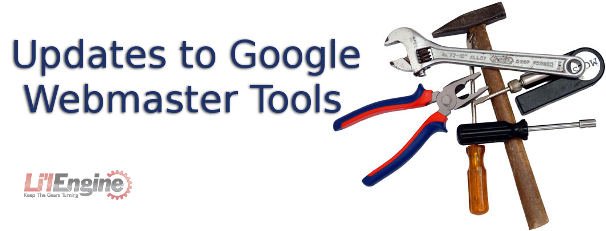
Have you opened up Google Webmaster Tools recently? If not, you should, because you’ll find a bunch of new features. Your webmaster tools dashboard shows top search queries, links to your site, crawl errors, sitemaps, and more, as you can see in the screen shot. From the dash, you can get more information on any of these. The next screen shot shows all the webmaster tools options that show up in the left hand column of your dashboard.


If, for example, you’re looking at your top search queries, which is located under the “Your Site on the Web” menu, you can go down to the bottom of the list where it says “more” and click. You’ll be taken to a page with a graphic representation of your queries by date, and a breakdown of individual search terms, and where you rank for them, as seen in the next screen shot. Also under “Your Site on the Web” you can find links to your site, keywords, internal links, and subscriber statistics.
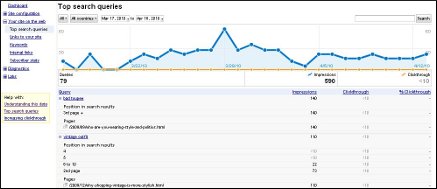
You used to only be able to see your site’s top 100 search queries, but now you can see many more. If your site ranks for more than 100, you’ll see page buttons at the bottom of the “Top Search Queries” list. And the graphic that appears of your top search queries used to be something you had to download and make into a chart yourself, so this new feature is especially handy. You also get a date range selector like what you have on Google Analytics so you can narrow down your data for a particular time period.
Under the “Site Configuration” menu, you can visit sitemaps, crawler access, sitelinks if any. These are the internal links that Google sometimes puts in search results, as you can see in the screenshot. There is also a “settings” section, in which you can set geographical targets, view your crawl rate stats, and parameter handling, which some webmasters use for more efficient crawling with fewer duplicate URLs. You don’t have to set any of these, because there are defaults, but some webmasters may want to. Some people have raised concerns that having country-specific sites will cause duplicate content issues, but this isn’t the case, so setting geographical targets will not harm your rankings.
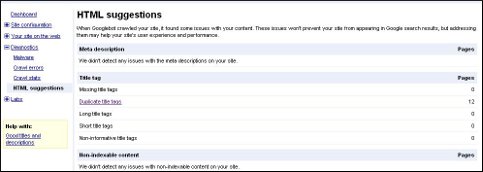
Diagnostics is another handy set of features. From the Diagnostics menu, you can check for malware on your site, crawl errors, crawl stats (which gives you Googlebot activity over the preceding 90 days), and HTML suggestions. The HTML suggestions page tells you if there are any problems with malware on your site, and a breakdown of title tag information, which includes duplicate or missing title tags, short title tags, non-informative title tags, and long title tags. It also alerts you if there is non-indexable content on your pages. Just FYI, the Malware diagnostic used to be under the “Labs” menu, but late in 2009 it “graduated” to the Diagnostics menu.
The Labs menu lets you play with new tools that may or may not stick around. One thing you can do is see what your site (either the homepage, which is the default, or a specific page, whose URL you type in) looks like to the Googlebot by choosing “Fetch as Googlebot” under the Labs menu. Once you click on “fetch” you’ll get a listing of your site and under Status, you should see “Success” and a green check mark. Click on “Success” and you’ll see the source information for your page as it is seen by the Googlebot.
You can make a Sidewiki for your site under the Labs menu, too. It may not be something you’re interested in, but a Sidewiki is a browser plugin for IE and Firefox that adds a universal commenting system for any and every page on the internet. To use it, you have to install the Google Toolbar for IE or Firefox, and Google says they’re working on a version for Chrome. When you install the toolbar with the Sidewiki in it, you go to a landing page telling you how to use it. Sidewiki entries are displayed with the most useful and high quality entries first, based on running the Sidewiki information through an algorithm to determine this. Toolbar haters will probably want to skip this one.
The Site Performance option under the Labs menu basically leads you through installation of the Page Speed browser add-on for Firefox that helps you figure how fast your site loads and what you can do to maximize load speed. Page Speed runs a bunch of diagnostics against a page and analyzes various performance parameters based on things like resource caching, upload and download sizes, and client-server round trips. You’ll get a red / yellow / green grading scheme for all the parameters, plus specific suggestions for making your page faster. It also does some automatic optimization such as compressing images and “minifying” JavaScript code.
This is very valuable information, and there are even suggestions and hints on how to do things like speeding up your site by installing a Firefox add-on called Page Speed. Honestly, you could spend half a day going through the data you now get from Webmaster Tools and probably come up with a dozen tweaks to your site that will fine tune its performance. Initial reaction to the new tools – particularly the top search queries – has been very positive.
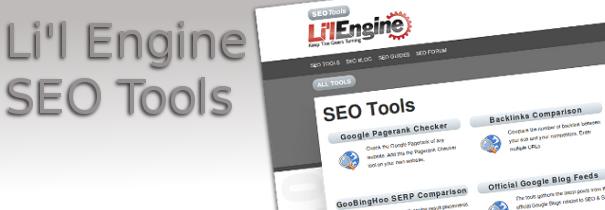
If you haven’t checked out our tools page, you should. We’ve got all kinds of things to make it easier to evaluate and improve your own website and find out how your competitors stack up.
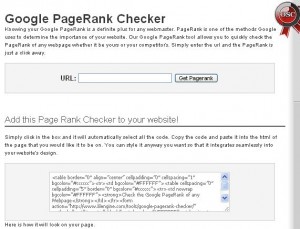 The Google PageRank Checker (see screen shot) does exactly what it says. You type in a URL and it tells you the site’s Google Toolbar PageRank. This is a “snapshot” of Google’s mysterious, patented PageRank formula that conveys the authoritativeness of a given page. There’s not actually a publicly accessible tool for finding the patented Google PageRank, but Google Toolbar PageRank will help you determine how authoritative a page is when used with other factors like a page’s back links, anchor text, and number of links. Keep in mind that a high PageRank doesn’t necessarily mean a site will rank high in the search results. PageRank is great, but search engine optimization is the key to ranking high in most cases.
The Google PageRank Checker (see screen shot) does exactly what it says. You type in a URL and it tells you the site’s Google Toolbar PageRank. This is a “snapshot” of Google’s mysterious, patented PageRank formula that conveys the authoritativeness of a given page. There’s not actually a publicly accessible tool for finding the patented Google PageRank, but Google Toolbar PageRank will help you determine how authoritative a page is when used with other factors like a page’s back links, anchor text, and number of links. Keep in mind that a high PageRank doesn’t necessarily mean a site will rank high in the search results. PageRank is great, but search engine optimization is the key to ranking high in most cases.
Back links are links that point to a site from other sites. They are a prime source of PageRank juice (though not the only source). Having a lot of high quality back links that are obtained honestly will seriously help your site’s Google rankings as well as PageRank. The Backlinks Comparison Tool lets you compare the number of back links to a list of websites. It couldn’t be easier: enter a URL on each line, then hit “Get Backlinks Count.”
The Google+Bing SERP Preview can show you how a web page will appear in the Google and Bing search results. This will help you improve your title and meta description tags. The screen shot shows a test case for lilengine.com with the fields filled in. You click “Preview” to get your results (seen in the next screen shot). Once you have your results, you can click on the “Compare” button. A new window will come up showing you how the results actually look in either Google or Bing results.
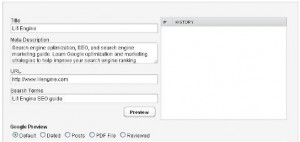
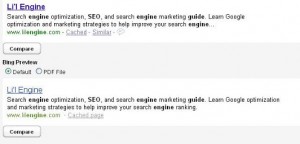
Our Official Google Blog Feeds is a site you should bookmark if you haven’t already. In one place it gives you live feeds from the following Google blogs:
The Link Report Tool analyzes the links on a given web page and generates a report. You type in a URL and click on “Generate Report.” You have the option of filtering links in a number of ways. For example, you can have it check all the links, broken links, internal, outbound, or redirected links, nofollow links (the kinds that search engines won’t follow), or unknown links, which for whatever reason can’t be analyzed. If you click on the link in the report, you’ll get a brief summary of the link, including the URL, the anchor text, the http response, and problems encountered. You can also view the link HTML from the web page. You can see in the screen shot the initial results of a report on a page from Techdirt.com.
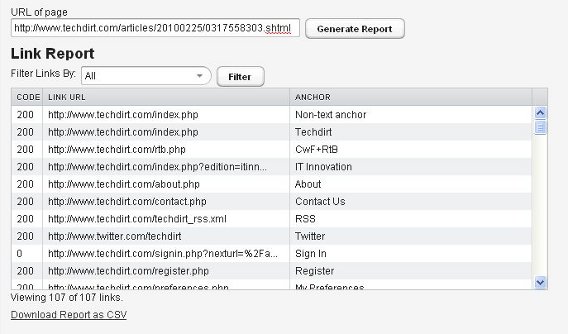
You can use the Google Penalty Checker to test for possible penalties from Google. You enter a domain name in the box and click “Check” to get a quick check of whether a site has been penalized. If you see warnings related to keywords on your site, you might want to investigate these. They may not mean a penalty has been issued, they do indicate that your SEO could be improved. If a site is not penalized, your result will be a happy green check mark indicating Google seems to think it’s A-OK. If a site has been penalized, you’ll see a big red “X” instead.
If you want to know the keywords a domain is ranking for in Google search results, you can use the Keyword Position Checker. You simply type in a domain name and choose which version of Google to check against (Google.com, Google.ru, Google.de, or Google.fr). The results include keywords, position, result count, and URL of the page in the results.
Our Keyword Competitors tool shows you the competitors that rank for the same keywords as your domain. Type in your domain name. You’ll get a report showing you your competitors. In the results, if you click on a competitor you’ll get a side-by-side comparison of keywords both of you rank for, and what position your site ranks for a given keyword.
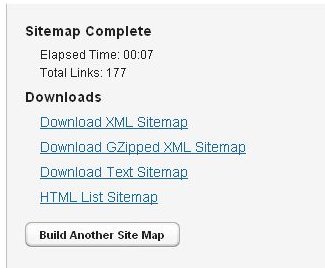 Hey, wanna get a sitemap for your new website? Use our Sitemap Builder. It’s easy. The tool crawls your website and makes a Google Sitemap. If you don’t have a sitemap, you should. It helps search engine crawlers like Googlebot find the pages on your site, determine their relative importance, and tell which pages have recently changed. You type in your domain, and in a matter of seconds the tool will generate a sitemap, as you can see in the screen shot. You can easily download your sitemap in several different forms.
Hey, wanna get a sitemap for your new website? Use our Sitemap Builder. It’s easy. The tool crawls your website and makes a Google Sitemap. If you don’t have a sitemap, you should. It helps search engine crawlers like Googlebot find the pages on your site, determine their relative importance, and tell which pages have recently changed. You type in your domain, and in a matter of seconds the tool will generate a sitemap, as you can see in the screen shot. You can easily download your sitemap in several different forms.
These aren’t all the tools in our toolbox, and we’re always updating and adding tools, so check out the tools page often and use these tools to help your site make it to the top of the search results.

If you’re looking to work your way up the search engine rankings, and who isn’t? Then one way to get some good insights into what works and what doesn’t is to see what your competitors are up to. What does that top ranking site have that your site doesn’t? It is surprisingly easy to find out these things, or some of them at least. One of the great things about the web is that finding who your competitors are is easy, as is comparing services and products. It’s a given that customers usually return to sites that are easy to browse and that have generous amounts of information, even if the visitors don’t partake of all of it.
Once you find out what the top ranking sites in your niche are, what should you do? Well, here are several things you can do.
You can find out some very interesting facts. For example, you might discover that a lot of the inbound links come from websites that the competitor owns. This isn’t always easy to find out, but it’s very informative if you can. The “whois” information may not give you much to go on, but if you do discover that this is the case, you may realize that owning some legitimate websites on the side can help attract more traffic to your site.
You might discover when browsing through your competitor’s site that even though the information on your site is similar, their site has a very different structure – a better optimized structure. It could make a big difference in their search engine ranking. You might discover that your competitor is using a bunch of keywords and key phrases that you never even thought of.
Start off simply enough. Get a pad of paper and a pen and make notes as you thoroughly do your own “crawl” of your competitor’s site. Look over the pages as they appear first, then go back and look at the source html. On most browsers you get this by pressing ctrl+U. If not, this command can often be found in the “Tools” menu of your browser. Don’t worry. You don’t have to be an html genius to learn from it.
Look at their title tag. Is it well written? Does it reflect a common syntax used throughout the site? On the home page, look for the H1, H2, and H3 tags. If you find them, your competitor uses heading tags within the page. Try to identify the actual text used in the headings. You will more than likely find some paydirt key phrases within these tags.
Look for nofollow tags. These are used to spread PageRank throughout the site. Doing this is what’s known as having a themed structure, and it can be very beneficial to your ranking. If you find this pattern, they either know their SEO or they’ve hired someone who does.
How do they do their navigation? Is it in a drop-down menu? Is it search engine friendly? In the footer is there a text menu?
Look at the anchor text: is there a pattern of keywords there? If certain words appear there often, they are almost certainly target phrases.
Check the Google PageRank of the pages you visit. If a page has a notably high PR, pay closer attention to that page. These are often pages that have the information that visitors choose to link to. It could give you some clues for adding similar content to your website.
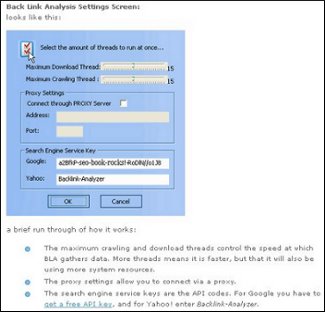 Here’s another cool thing you can do with your competitor’s website: back link analysis. SEO Book offers a free back link analyzer that you can download here. You enter simple information as you can see in the screen shot. When you run the program, set it up to acquire Google Rank and Alexa Rank for each back link. This is a matter of checking two boxes. The back link analyzer automatically filters out “rel=nofollow” links.
Here’s another cool thing you can do with your competitor’s website: back link analysis. SEO Book offers a free back link analyzer that you can download here. You enter simple information as you can see in the screen shot. When you run the program, set it up to acquire Google Rank and Alexa Rank for each back link. This is a matter of checking two boxes. The back link analyzer automatically filters out “rel=nofollow” links.
When you’re done, you can sort your results by PageRank and Alexa Rank. The reason for looking at both Alexa and PageRank is that each has its advantages and disadvantages. PageRank may be quirky due to whatever they’re penalizing recently, so you could miss out on a quality site because of its low PR. Alexa Rank is a measure of popularity, but doesn’t say anything about how Google views its quality. So use both as a system of checks and balances.
If you really want to delve into things, put your report data from the Back link analyzer into a spreadsheet. Make a copy where you sort the data by Google PR from highest to lowest. Then get rid of the ones that rank less than 4. Have another copy where you sort by Alexa Ranking from lowest to highest, and then do another sort by Google PR from highest to lowest. Get rid of the ones that have a negative Alexa Ranking. Congratulations: you now have lists of authority pages that link to your competitor.
So now that you have that data, what do you do with it? If you filter the links by domain, you can see how many links per domain the competitor is getting. If one website is repeated a lot, then you can bet that the competitor owns the website (or has bought a link from them). You can try running a “whois” on the domain, but you may not get a satisfactory answer.
Here’s another thing: if you see that a lot of the links are from the competitor’s own website, then chances are they have good content. If so, take note. You may need to focus on increasing your content or the quality of it.
Next you should figure out which of those links you’d like to get yourself. You can probably get several just by asking. It certainly can’t hurt (unless you accidentally ask for back links from sites that happen to be owned by the competitor, and even then, you might get a link).
In the midst of all this competitor sleuthing, don’t forget about your site. You’re doing this to learn, so be ready to apply some of what you find out to your own site, and hopefully you’ll get a boost in the rankings as well.
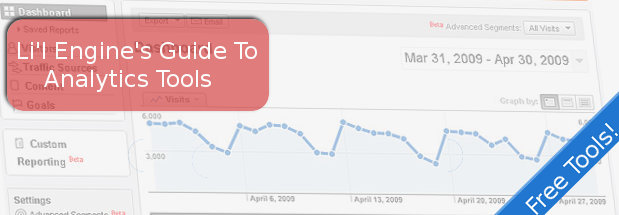
Whether you have a blog or a full-fledged e-commerce site, you probably are curious about how many people visit your site, which pages are most popular, how many page views you get, and how long visitors stay around. Fortunately, there are several free analytics programs you can get right online to help you dig into the numbers your website is generating and learn what stories those numbers tell. Four such programs are Onestatfree.com, Google Analytics, Piwik, and GoStats.
Onestatfree.com is a free subset of onestat.com, which provides web analytics for marketers and webmasters. The paid version starts at $125 per year and provides information on visitor behavior, conversions, and online advertising, plus a full range of website statistics software. Onestatfree is a hit counter that is password protected and has the ability to track an unlimited number of pages. It also gives you information about your visitors and your site for free. You can see an example of the information Onestatfree gives you on the first screen shot. To get Onestatfree, just go to onestatfree.com and register. You’ll be given a snippet of code to insert into your website’s source code that will start monitoring and analyzing visits to your site.
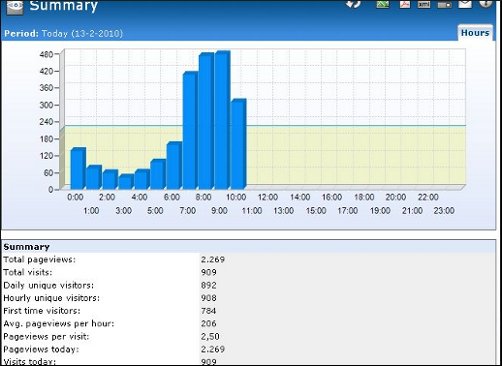
Onestatfree has a directory based on web statistics, and when you use the service, your website is automatically listed in the categorized charts based on web statistics. This is a way to easily see the most popular websites in each category based on Onestatfree statistics. Your site starts being listed as soon as the first visit is tracked by the counter. Categories of websites in the directory are: Arts, Business, Children, Computers & Internet, Culture & Religion, Education, Employment, Entertainment, Finance and Money, Games, Government, Health & Fitness, Hobbies & Interests, Home & Garden, Life & Family, Marketing, Movies & Television, Music & Radio, News & Media, Personal Homepages, Pets, Science & Technology, Society, Sports, Tourism & Travel, and Weblogs.
Google Analytics is perhaps the most famous of the free analytics packages. It gives you a broad range of information about your site, including advertising return on investment, cross-channel multimedia tracking (as you can see in the second screen shot), customizable reporting, and many ways to visually represent your site’s analytics. Using Google Analytics is also a matter of installing code into the source code of the website you want to track. Users of Google Analytics include some big names, like The American Cancer Society, Discount Tire, Yelp, Huffington Post, and RE/MAX Global Real Estate.

If you use Google AdWords, then you can integrate Google Analytics with it and review your online campaigns and track things like the quality of your landing page and your conversions. You define conversions as sales, lead generation, page views, or downloads. You can also use Google Analytics with Google AdWords to determine which ads perform best. You can identify poorly performing pages by looking at where your visitors come from (their referrers), and their geographical location. You can add up to 50 site profiles to Google Analytics, and each site must have traffic lower than 5 million pageviews per month, unless the site is tied to an AdWords campaign, in which case it can be bigger in terms of visitors.
Piwik is an open source, GPL licensed website analytic software program that is downloadable. Piwik gives you real-time reports on website visitors, including information like which keywords and search engines they used, what language they use, and which of your pages are most popular. Piwick calls itself the open source alternative to Google Analytics. It is a PHP MySQL program that you download and install. After the installation process, you get a JavaScript tag that you copy and paste into the source code of websites you want to track. An example of the type of reports you can get is shown in the third screen shot.

Piwik is constantly adding new features, like goal tracking, that can help you optimize your affiliate income if you participate in an affiliate program. Piwik 1.0, to be released in 2010, has already added some new features, like a one-click update check, new JavaScript tagging, and a dashboard to track multiple sites.
Gostats is another free hit counter that provides stats on not only the number of visitors to your site, but also information about page views, page popularity, and return visitors, as you can see on the fourth screen shot. Like the other free analytics software programs, you visit gostats.com, create an account, and copy and paste a small bit of code into your website’s source code. GoStats will then start tracking your site data. If you want more data than the free version of the software provides, you can upgrade to the professional version of GoStats. Another interesting page on the GoStats site is a huge chart comparing web hosting services in terms of price, how much disk space and bandwidth they provide, monthly cost, and initial setup cost. The three plans highlighted in green at the top of the chart are paid listings. You can narrow the chart down by specifying monthly costs or setup costs.
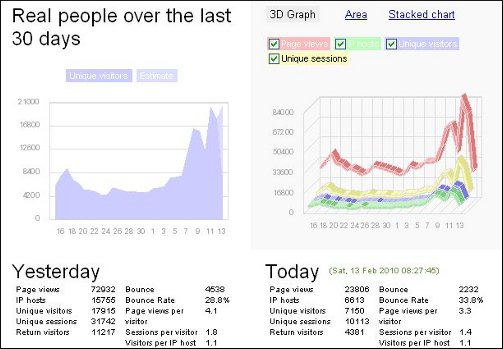
If you upgrade to GoStats Professional, you’ll get comprehensive site and data analysis, with regular reports and displays of visitor traffic on a map of the world.
Web analytics can be as simple or as complex as you want them to be. Whether you simply want the ego boost of knowing that your blog is being read, or whether you need lots of numbers crunched in order to maximize your site’s profitability, you can get that functionality easily. While Google Analytics is the leader of the pack, there are plenty of other options that you can try so you can find the analytics that are right for you.
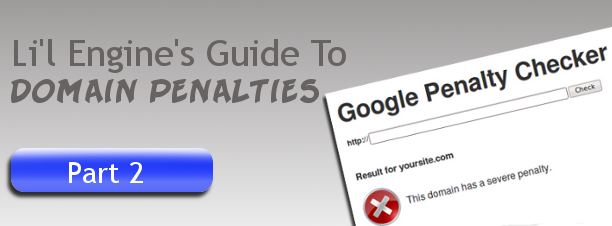
In Part I, we talked about how to determine if your site has been banned or penalized by Google and what to do about it. This part delves more into Google penalty folklore, and how the search engine is constantly changing and evolving to counter nefarious work-arounds that people develop to game the search engine world.
In August and September 2009, Google made changes that demote a site by 50 places in the rankings if you are penalized. At this time, variation of anchor texts grew in importance even more than it had in previous years. The “rules” of building natural anchor text change a lot. Not that you should stop using natural anchor text. More on that later.

The so-called “minus 50 penalty,” a filter in Google operates on the domain, page, and keyword level. In other words, pages drop by 50 positions in the ranking because of over-optimization of keywords the page has been linked to, either internally or externally.
What does this mean? Un-optimize your keywords?
Actually, yes.
Since the moods of Google change fairly rapidly, the things that worked last year may not work now. If you’re hit with a penalty, all you can do is fix the problem, suck it up, and move on starting today. Various webmasters have said that it takes 60 days to get rid of the penalty, so the sooner you deal with it the better.
Something else you must do is change up your anchor texts. Don’t just use one hot keyword to link all your links. And you can’t just vary them singular and plural. You have to use everything from natural language phrases to pieces of keyword phrases to misspellings and typos. What you don’t want is to overdo the linking with the hot keywords and phrases. Write your anchor texts as if you don’t care about squeezing every last bit of juice out of a particular keyword or phrase.
When it comes to anchor text variety, your best bet for figuring it out is to check out what your best competitors are doing because there’s no exact number of times a keyword text can be used to anchor links. The key is not to be too far out of line when compared to your competition.
Page level penalties are becoming more common, whereas before, penalties were usually applied at the domain level. In many cases the page level penalties are hitting home pages of sites. Key phrase specific penalties are becoming more common too. This happens when there are easily detected paid links pointing to a page with exact anchor text for one key phrase. The problem is, the page can continue to get search traffic for some phrases, but not the one you want.
Apparently the reason Google does it this way is that sometimes Google susses out paid links, and sometimes it doesn’t. If the algorithm is going to hand out penalties for paid links, it needs to prevent itself from messing things up for a site too badly if the algorithm thinks there are paid links when there aren’t. Therefore, they limit the penalty to one specific page and one specific key phrase so that an entire site isn’t penalized in the even to of a mistakenly applied penalty. Of course, the best thing to do if you have paid links is get rid of them and wait for your site to be crawled again.
These page level and key phrase specific penalties are sometimes hard to detect, but there are some things you can do that might give you clues that your site is on the receiving end of a page level key phrase specific penalty.
The moral of this long story is that while domain level penalties appear to have peaked, you have to watch out for page level and keyword specific penalties. While Google’s intentions in doing this were probably honorable, these penalties can be a little harder to figure out than domain level problems, particularly keyword and key phrase level penalties. If you have paid links, shady links, or happen to link to a nice looking site that itself has questionable link issues, you need to fix these things now. It isn’t always easy finding out which of the sites you link to themselves link to porn or other dodgy sites, but it’s worth checking out. The bottom line is that if you shun all questionable practices, build links organically, and continue to provide fresh, relevant content with natural sounding anchor text for links, your site will bubble upward and is almost certain to resist getting penalized.
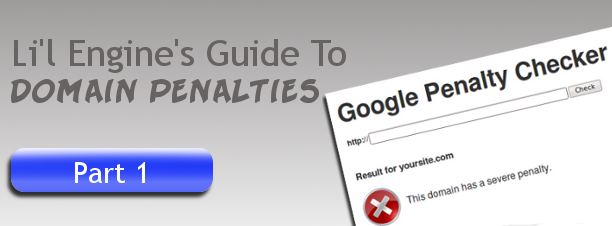
Has your website’s search engine ranking dropped drastically for no apparent reason? It is possible that your site has been hit by a domain level penalty from Google’s web spam team. A domain level penalty means your whole site has been demoted drastically in the search engine rankings – not just certain pages of it. The bad news is this can be difficult to pin down. While there are tools to help you figure out if your site has been penalized, there is a degree of speculation about it.
When your site’s Google search engine ranking takes a hit suddenly, then you can pretty easily conclude that you have done something wrong in the opinion of Google. They’re not all that specific about what happens when they “catch” you doing something wrong, and exactly how they penalize you. But in general, there are a few categories into which these mistakes fall, and there are ways to make a reasonable conclusion about which sin you’ve committed.
Cataloging the various Google penalties people have come across is like trying to herd cats. Whatever relationship exists between the punishment and the crime either isn’t transparent, or is not handled evenly across the board. Being banned is, of course, as bad as it gets, since your site is suddenly not able to be found. This usually only happens when some kind of serious deception is going on on the site. But there are a few activities that have been pinned down as sending the Google gods into a frenzy.
Domain level redundancy is one thing that can get you penalized. This is what happens when webmasters clone sites. In other words, they point the Domain Name System (DNS) from several domains into the same directory. This makes each domain display exactly the same site.
If you duplicate the same content over several pages or sites, or if someone copies your site or content, Google will ding you for content redundancy. If you think someone else is ripping off your content, check Copyscape and see if you can track it down.
Purchasing a number of domains, each of which address separate keyword targets is now considered punishable.
If Google thinks you’re a link seller, your links will rapidly mean zilch. If your links do not pass on PageRank juice, they’re worth less than the pixels they’re written on, even if you are using them on your own site.
There is a certain amount of mystery surrounding the Google “sandbox” theory. Some people believe that young sites are penalized. You don’t see this penalty unless you try to SEO the heck out of it within the first few months of the site’s existence. Apparently there is a certain amount of dues paying your site has to do before your SEO starts getting respect from the big guys.
Does your site support (or appear to support) porn, gambling, or “male enhancement” sites? Well, duh. Of course you’re going to get penalized. Same with spam.
If your site may be perceived as a threat to national security, like if you sell fake IDs or something, your site will be penalized. If a third party hijacks your search engine rankings by means of cloaking and proxy, unfortunately, your site gets hit with a penalty. This one is mostly Google’s fault. The same is true if an affiliate uses content from your site, or if your competitor intentionally links to you from “bad neighborhood” (porn, gambling, etc.) sites.
And, of course, there’s the fact that the Google algorithm isn’t perfect. Algorithm quirks can have the same effect as a penalty if it makes your site unreachable.
If you want to find out if your site has been penalized, we have a free penalty checker tool you can use if you go to http://tools.lilengine.com/penaltychecker/. Click the button below to give it a try.
You just input the address of the site you want to check out, and you’ll get a result either like screen shot one (when a site does appear to have been banned or penalized) or screen shot two (when a site is not believed to have been penalized).
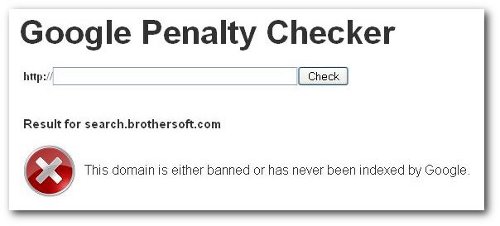
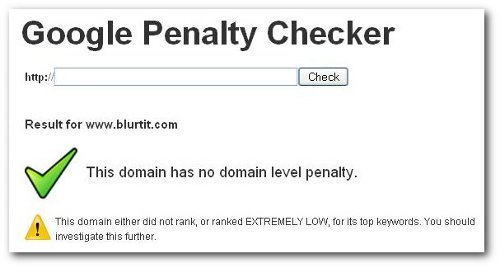
If you suspect your site has been penalized, there are a number of steps you can take to find out if it has, and why. Once you fix the problems, you can request re-instatement by the Google search engine and eventually get back in its good graces.

Face it: even if your website is a personal blog on a topic that you are passionate about, and isn’t an e-commerce site, it’s still dispiriting to look at your stats and find that only half a dozen people have visited. Everybody wants their site to get noticed. And there are enough web users that no matter what the topic of your site, there are plenty of people out there who are interested in it. What your site needs is probably some search engine optimization (SEO) to bump the numbers up and get more eyeballs on your page.
Ultimately, the success of a site depends on your ability to effectively communicate with readers. There is no substitute for content that people like, though there are things you can do to tip more traffic your way. A lot of people with blogs (whether they are designed to drive traffic to e-commerce sites or not) discover that there are a number of SEO plugins that can automatically do some of the SEO work for them. These plugins, such as Google XML Sitemaps, help the major search engines index your site better. With a sitemap, the crawlers have a much easier time “seeing” the structure of your site and retrieving it efficiently. Google XML Sitemaps notifies all the major search engines whenever you post new content.
 With plugins, however, there can be too much of a good thing. More than four or five plugins and your site may slow down, and in some cases plugins can crash each other, in which case neither is helping your site. Not all SEO tools are plugins, however, and there are a number of SEO tools that help you do those things that you may not be so sure about doing, like generating meta tags.
With plugins, however, there can be too much of a good thing. More than four or five plugins and your site may slow down, and in some cases plugins can crash each other, in which case neither is helping your site. Not all SEO tools are plugins, however, and there are a number of SEO tools that help you do those things that you may not be so sure about doing, like generating meta tags.
That said, since so many new webmasters use WordPress for hosting, here are a few of the more popular plugins for WordPress SEO and what they do.
SEO Smart Links automatically links the keywords in your posts to corresponding posts and pages. This is awesome because it provides a way to keep visitors on your site and clicking those page views. In addition to the automatic functions, you can specify custom keywords and the URLs you want them to link to.
Robots Meta is a simple plugin that lets you ad meta tags to hide comment feeds from the search engines, hides internal search result pages from search engines, and hides admin pages from search engines, thus keeping your SEO info from being “diluted” by these things.
HeadSpace is a popular plugin that is capable of automatically generating post tags from a post’s content. This is terrific for people who have a hard time categorizing and tagging posts.
All In One SEO Pack is the most popular of the WordPress repository of plugins. It allows you to optimize parts of your site like the site title, the keywords, and the page titles. It can also generate keywords based on content of the current post. As you can see from the screen shot, this is extremely popular – at times being downloaded over 40,000 in a day!
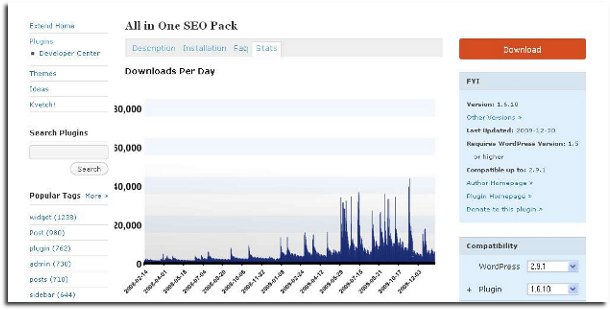
One thing you need to do to be able to optimize your site is to see how it looks to the search engine crawlers. You also want to be able to generate meta tags with some help for optimum results. It is good to see if you have duplicate (or nearly duplicate) pages on your site (which can harm your search engine ranking), and to see if anyone else out there is stealing your content (and readers). Here are a few tools that you might consider.
Similar Page Checker, by webfconfs.com helps you determine if your web page content is too similar to another page on the same website. Search engines will ding you for having pages that are too similar on your website. All you do is enter the URLs and Similar Page Checker compares the content.
Webmaster Toolkit’s Web Page Analyzer checks your page to ensure that you have keywords in bold text, header text, link text, document titles, meta keywords, and meta descriptions. This is considered an “entry level” tool, but it may be perfect if you’re just starting out with SEO for your site. As you can see from the screen shot, it couldn’t be simpler: you enter URLs and keywords and Web Page Analyzer checks for optimization.
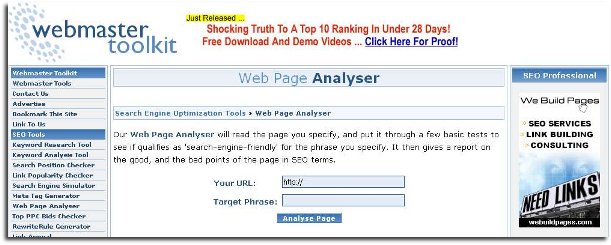
Code to Text Calculator by Stargeek tells you the ratio of text to code. The higher the ratio of text to code on a page, the better. You enter URLs and it calculates the code to text ratio.
Copyscape is a workhorse tool that helps you find websites that are ripping off your content. It also finds websites that quote you. The copyscape website has information about what you should do if you find another site taking your content without permission.
If you find out that one of your URLs is banned by the Google database, you’ll probably be angry about it, but it’s better to know than not to know. Google Banned Checker Tool 1 lets you know if your URL is in the Google database. Keep in mind that if your site is new, it may not show in the Google database, but that doesn’t mean you’ve been banned. This toolkit is primarily for people who think their site has been punished by the Google gods.
Cache.it by cached.it shows you a lot of information you probably don’t know about your site, like your IP address, meta tag text, Alexa ranking, ping time, and PageRank.
Meta Tag Generator by SearchBliss does exactly what it says, creating up to nine meta tags.
Another “spider-view” tool is Search Engine Spider Simulator by webconfs.com. It shows you what your site looks like to the web spiders.
SEO isn’t just in the purview of big web companies. You can use SEO tools for whatever kind of site you have, whether you’re selling fishing tackle or reviewing movies. There are a lot of tools available to help you get your site indexed and seen by a lot more people, and these tools are worth your while.